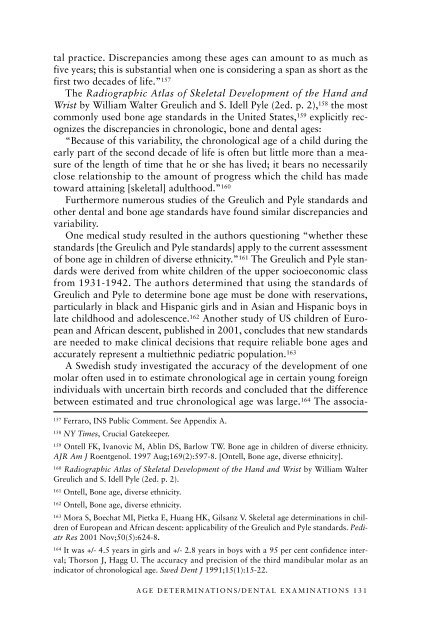From Persecution to Prison - Bellevue/NYU Program for Survivors of ...
From Persecution to Prison - Bellevue/NYU Program for Survivors of ...
From Persecution to Prison - Bellevue/NYU Program for Survivors of ...
Create successful ePaper yourself
Turn your PDF publications into a flip-book with our unique Google optimized e-Paper software.
tal practice. Discrepancies among these ages can amount <strong>to</strong> as much asfive years; this is substantial when one is considering a span as short as thefirst two decades <strong>of</strong> life.” 157The Radiographic Atlas <strong>of</strong> Skeletal Development <strong>of</strong> the Hand andWrist by William Walter Greulich and S. Idell Pyle (2ed. p. 2), 158 the mostcommonly used bone age standards in the United States, 159 explicitly recognizesthe discrepancies in chronologic, bone and dental ages:“Because <strong>of</strong> this variability, the chronological age <strong>of</strong> a child during theearly part <strong>of</strong> the second decade <strong>of</strong> life is <strong>of</strong>ten but little more than a measure<strong>of</strong> the length <strong>of</strong> time that he or she has lived; it bears no necessarilyclose relationship <strong>to</strong> the amount <strong>of</strong> progress which the child has made<strong>to</strong>ward attaining [skeletal] adulthood.” 160Furthermore numerous studies <strong>of</strong> the Greulich and Pyle standards andother dental and bone age standards have found similar discrepancies andvariability.One medical study resulted in the authors questioning “whether thesestandards [the Greulich and Pyle standards] apply <strong>to</strong> the current assessmen<strong>to</strong>f bone age in children <strong>of</strong> diverse ethnicity.” 161 The Greulich and Pyle standardswere derived from white children <strong>of</strong> the upper socioeconomic classfrom 1931-1942. The authors determined that using the standards <strong>of</strong>Greulich and Pyle <strong>to</strong> determine bone age must be done with reservations,particularly in black and Hispanic girls and in Asian and Hispanic boys inlate childhood and adolescence. 162 Another study <strong>of</strong> US children <strong>of</strong> Europeanand African descent, published in 2001, concludes that new standardsare needed <strong>to</strong> make clinical decisions that require reliable bone ages andaccurately represent a multiethnic pediatric population. 163A Swedish study investigated the accuracy <strong>of</strong> the development <strong>of</strong> onemolar <strong>of</strong>ten used in <strong>to</strong> estimate chronological age in certain young <strong>for</strong>eignindividuals with uncertain birth records and concluded that the differencebetween estimated and true chronological age was large. 164 The associa-157Ferraro, INS Public Comment. See Appendix A.158NY Times, Crucial Gatekeeper.159Ontell FK, Ivanovic M, Ablin DS, Barlow TW. Bone age in children <strong>of</strong> diverse ethnicity.AJR Am J Roentgenol. 1997 Aug;169(2):597-8. [Ontell, Bone age, diverse ethnicity].160Radiographic Atlas <strong>of</strong> Skeletal Development <strong>of</strong> the Hand and Wrist by William WalterGreulich and S. Idell Pyle (2ed. p. 2).161Ontell, Bone age, diverse ethnicity.162Ontell, Bone age, diverse ethnicity.163Mora S, Boechat MI, Pietka E, Huang HK, Gilsanz V. Skeletal age determinations in children<strong>of</strong> European and African descent: applicability <strong>of</strong> the Greulich and Pyle standards. PediatrRes 2001 Nov;50(5):624-8.164It was +/- 4.5 years in girls and +/- 2.8 years in boys with a 95 per cent confidence interval;Thorson J, Hagg U. The accuracy and precision <strong>of</strong> the third mandibular molar as anindica<strong>to</strong>r <strong>of</strong> chronological age. Swed Dent J 1991;15(1):15-22.AGE DETERMINATIONS/DENTAL EXAMINATIONS 131



